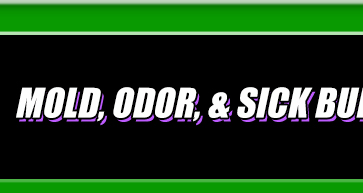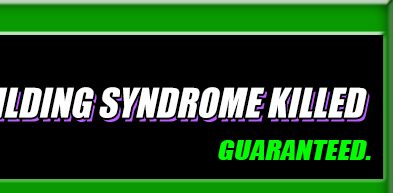100 Ways Mold & Sick Building Syndrome Invades Homes
* 1 Star indicates smaller influences on causes of mold
***** 5 Stars almost always create mold infestations sooner or later
FLOORS
****Water intrusion fuels mold in a home even when wet material is torn out
****Pet accident leaves behind bacteria that feed mold, the odor is toxic - a black light will help find them
**Saliva, blood, sweat & bodily wastes from humans, animals & crime scene situations
*Pets sleeping area - Let them sleep on a blanket and wash it regularly.
****Wet carpet & fabric takes only 6 - 8 hours to start growing organisms, extract & dry quickly
*Wet towels dropped on the floor - Mom is right, hang’em up!
**Drink spills sour from bacteria - bacteria feeds mold growth
**Stains reoccurring after cleaning up are living organisms
***Food particles in carpet and furniture grow bacteria and mold
*Mold tracks in on feet - can you teach the kids and pets to wipe their feet before entering home?
***Contaminants that fall to the floor and breed leave pets and kids most exposed
*Mold & bacteria loves cardboard boxes - they often decay over time from mold feeding on them
***Invisible mold colonies spew out at you when you walk by them throughout a building and can cause it to spread
*Dog poo is on 96% of shoes - that may be a little too much info!
***Tile, flooring, wallpaper or paint placed over mold temporarily masks a problem - it can loosen over time
*****Carpet fully saturated with mold or bacteria can feel cool, damp & dense like soil because it is turning into a garden.
BEDROOMS AND CLOSET
***Closets - needs air flow, open and close door each day
**Closet - Mold shows up faster on shoes and leather - keep shoes in a well ventilated area
*Cloths discolor and smell with bacteria from sweating - let dry before throwing in a hamper
*Clothes & jackets - let dry with air flow or fan before putting in closet
*Mold & odor spreads in drawers and closets
*You can wear mold that lives in your clothes - when you move it moves
*Clothes left overnight in a washer mildew - rewash with ½ cup of white vinegar or soak or add Oxyclean to the load and let soak over night
*Dryer vent - damp lint escaping indoors
**Buying items from musty places - you are bringing contaminants home
**Clothes with mold or bacteria can cause rashes
*Dog poo and contaminants on shoes - hard leather is decaying leather
***Locker room odor is a living bacteria
*Athletes foot is a living organism
*Gym bags and sporting equipment - game odor is bacteria contaminants
*Helmets, work vests and boots collect bacteria & smell over time
*Sweating in bed is bacteria - let the fan dry it by pulling back the sheets for a bit
***8 million dust mites living in an average bed - part of eco-system that feed other pests
*Sweat, dead skin cells and droppings from dust mites, etc create mold in beds
**Trunks - they generally stayed closed and get musty
*Clothing history: Manufactured over seas, put in box, on a cargo ship, in a truck, in a retail store then in your home - picking up contaminants along the way. Add ¼ - ½ cup of white vinegar to your washing machine at the start of a load
BATHROOM
****Mildew is mold - bleach removes the color of the excrement & smell, but can fuel the microscopic mold. EPA suggests using cleaners like detergent, Windex or Fantastic
****Leaky pipes - applying special pipe putty from a hardware store may fix it
***Sweaty pipes - may need to be insulated
****Flooding will inevitably cause mold in weeks or years
*Wash cloths, squeeze excess water out and hang up
**Steam from shower - use exhaust fans if available until mirror clears
****Cabinets under sinks with drips, condensation or leaks
*Shower curtains - spread out to dry, wash periodically in white vinegar
*Old (bottles of) products that smell bad inside are often tainted with bacteria
*Soap scum or a dusty looking film in showers and on items is often mold
***Wall paper loosening is usually due to mold growing behind it
*Wallpaper paste and some adhesives feed mold growth
*Oops, he missed the toilet
****Sewage backup is extremely harmful from toxic bacteria
****Grout: drying out, discoloring or cracking - Mold is devouring it, best to replace it when it shows signs of aging
***Faucet dripping - 1 drop of water per second = a large trash can a month or a pool in a year - that moisture fuels mold
KITCHEN
*Under the fridge and gaskets around the doors
*In the fridge - toss out of date food each week
**Rotting food can create contaminants
*Boxed foods, sugar, flour, etc. can be infiltrated with mold - even take on the musty taste
*Moldy foods should be discarded - Do not eat mold - it is toxic, NOT penicillin
**Rust is a form of mold - don’t eat food from a rusty can
*Smelly trash cans are alive with mold & bacteria - use bags
*Smelly sink drains - pour white vinegar, Pinesol and/or boiling water down it and grind with water running
*****Dining areas with carpeting - especially in restaurants - sour smell of bacteria
*Plants grow mold & bacteria on leaves, in soil and sitting water - best left outside
***Pipes leaks seeping into cabinets and behind walls
**Caulking loosing around sink back splash allows moisture between walls
*****Appliances with water lines that bust and flood
***Overflowing drains
*Sponges - throw in dishwasher or washing machine when you wash a load
*Fresh fruit, vegetables and breads regularly getting moldy is from SBS
*Fresh produce & bread go bad faster from mold, bacteria and bugs - Our technology is used by Agricultural Coops to treat fruits and vegetables to help them last 5 - 10 days longer & to neutralizes the pesticides
HVAC or A/C RELATED
****HVAC- can start or spread contaminants - get yearly maintenance
***Rust around HVAC system is a sign of moisture in or around it
*****Regularly turning the HVAC off when building is not in use -schools and churches are a prime example
***Clogged drain on HVAC that goes to outside - vacuum out
*****Dirty A/C filter each month can be a sign of mold and what is attaching to it and to your lungs!
***Visible mold around an HVAC unit
*Duct work - duct cleaning does NOT kill the living organisms
**Holes in underground ducts pull in contaminants and creatures living underneath
*****Dust around vents is commonly mold coming out of the ducts
***Condensation in ducts - do not lower the thermostat too drastically
***A/C unit to big for a home - will not stay on long enough to remove excess moisture
**Great weather - temperature outside is such that the HVAC unit has not kicked on for several days - turn the A/C fan or open the windows for a bit
GENERAL
***Increased moisture & rain fuels the existing deadly toxins and attracts pests indoors
*Pests carry in mold & bacteria on their feet
*Trash left between walls during construction
***Mold decreases property value and continuously devours a home
****Disturbing visible mold amplifies the toxic effects and causes it to spread
****Fabric, paper & boxes break down, come apart or disintegrate from mold
***Storage areas & basements without air flow - crack open 2 windows if possible
***Moving items from a moldy home or storage - the mold moves with your items
****Lack of air flow - keep HVAC & fans on even when away
*Sprinklers hitting the house regularly
*Pests droppings turn moldy
*Plants growing up the walls of a home grow into it and allow water to seep inside
**Pressure washing the outside of a home and it sprays through the windows
**Condensation around windows - place Damp rid buckets in the corner to absorb moisture (from hardware or big box stores)
***Vacant homes with still air - leave all fans on high
****Vacant homes with no power WILL have problems sooner or later!
*****Sellers covering up problem
***Ceilings or walls with stain spots is mold growing
**Mold settles on top of baseboards
**Dark circles on commercial ceiling tiles - leaks & duct work condensation
***Sheet rock, plaster and tape loosening can be from (old) leaks
***Building materials becoming damp before or after installation
**Bringing in moldy equipment - especially those with blowers or fans
**Spare rooms closed up are more susceptible - keep the door open and fan on
***Porches with mold enter home when door is opened
***Musty basements with airflow into the house
**Items stored in stinky garage when brought into home
***Adjoining neighbors with water leaks - Infrared testing for leaks in walls
*Antiques - 50% of homes have issues, furnishings can pick up SBS over the years
*Pictures can grow mold under glass
*Leather furniture often cultivates mold faster then cloth, vinyl or wood
*Antique painting use paint or food materials - mold & bacteria dull a painting
**Historical & museum artifacts
***Anything in a home that stays wet for a day or two
*Rubber gaskets can pit or rot from mold
*Household dust and dead skin cells feeds mold
*Smelly stuffed animals & blankets
*Saving used baggies, paper towels or tissues harbor bacteria and mold
**Moldy vehicle - you get continuous exposure
*16% humidity can maintain mold growth
**Mold or bacteria in attics and crawl spaces if open into the house
***Indoor fountains, pools, hot tubs, etc.
***Mold falls 2 inches per day and easily moves through a building
*Air purifiers, ionizers, ozone machines, etc. - circulating moldy air & grows in unit
*Dehumidifiers can harbor mold - run 6 hours and empty to prevent growth
***Humidifiers can fuel mold growth
**Painting over mold is a temporary cover up even with Kilz
**Bubbling and peeling paint usually comes from painting over mold
***Warped or deteriorating walls comes from moisture intrusion
***Saving mail, paper and boxes - they love mold - purge periodically!
*Chest with stored items - keep it opened ½”
****Hoarding is very toxic & can cause major health issues even after a clean out - PURGE!
****Someone or something died and fluid or particles left behind begin to decay
OTHER SBS CONTAMINANTS
**Decaying dead roaches create airborne asthma aggravators
*Bugs and rodents droppings leave behind deadly contaminants
***Cigarette smoke leaves behind benzene even with renovation
*****Masking bad odors - Air fresheners, plug-ins, scented laundry detergents, perfumes and most anything scented you can purchase from big box stores are an irritant and carcinogen. When I talk to people with cancer, most use perfumes; scented items in their home; on their body and/or in their laundry. Instead use pure and safe essential oils on your body, in your dryer on a wash cloth and in the home. (Best to ask your local health food store or massage therapists) Avoid common petroleum based candles… soy is best. Use lemon peel, cinnamon, pine needle, etc. as potpourri.
Recognizing Mold & Sick Building Syndrome in homes
*You feel better when you go away from your home for a while
*Electronics seem to have shorter life spans - rust is a form of mold
*****Resident uses fragrances in a home to disguise unpleasant odors
*****Repeat: Use of fragrances is a sign of covering Sick Building Syndrome
***Residents needing the use of air purifiers
*The home or office is affecting some or all the adults, children and/or pets
*Being diagnosed with mold in your body
*Couples are having disagreements as to the issues in the o2wizard.com website
*Too much of your time off and extra money is being spent on medical care from years of mold exposure
*Illnesses may worsen when it rains or from moisture intrusion
*Your health should be improving but for some reason, it is not
*Mold test kit - Pour in the liquid auger, leave in 2-3 rooms for 1 hour each. It can be done after sweeping, vacuuming or dusting. Cover and place in a dark area for 3 days.
****Some or all rooms have an unpleasant odor
*Entire home has the same smell - in a home with no contaminants, you should smell different items through a home: soap and shampoo in bathrooms; spices and foods in the kitchen; candles in the living-room; toiletries in the bedroom; new leather in closets; etc.
****If you have asthma or allergies - a moldy home depletes your health - some issues become permanent from too much exposure
Ask yourself these questions?
- Is Sick Building Syndrome affecting your health?
- Do you smell an unpleasant odor?
- Do you see it anywhere in the house?
- Have any known incidents above occur?
O2 Wizard is Your Indoor Air Quality Solution.
Contact us today for Your FREE Indoor Air inspection and evaluation.
Kimi Ayers, Ms. Mold & Mildew, Indoor Air Quality Experts
OSHA Authorized, Mold Instructors & Experienced in Construction
Florida State License #: MRSR2516











